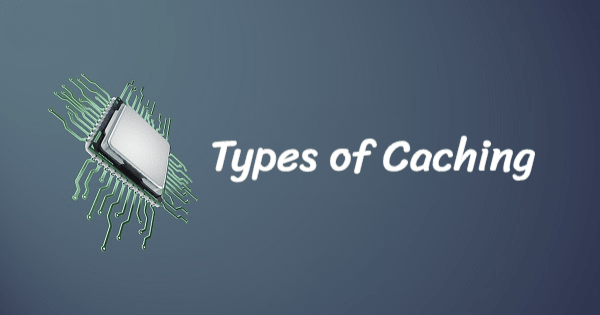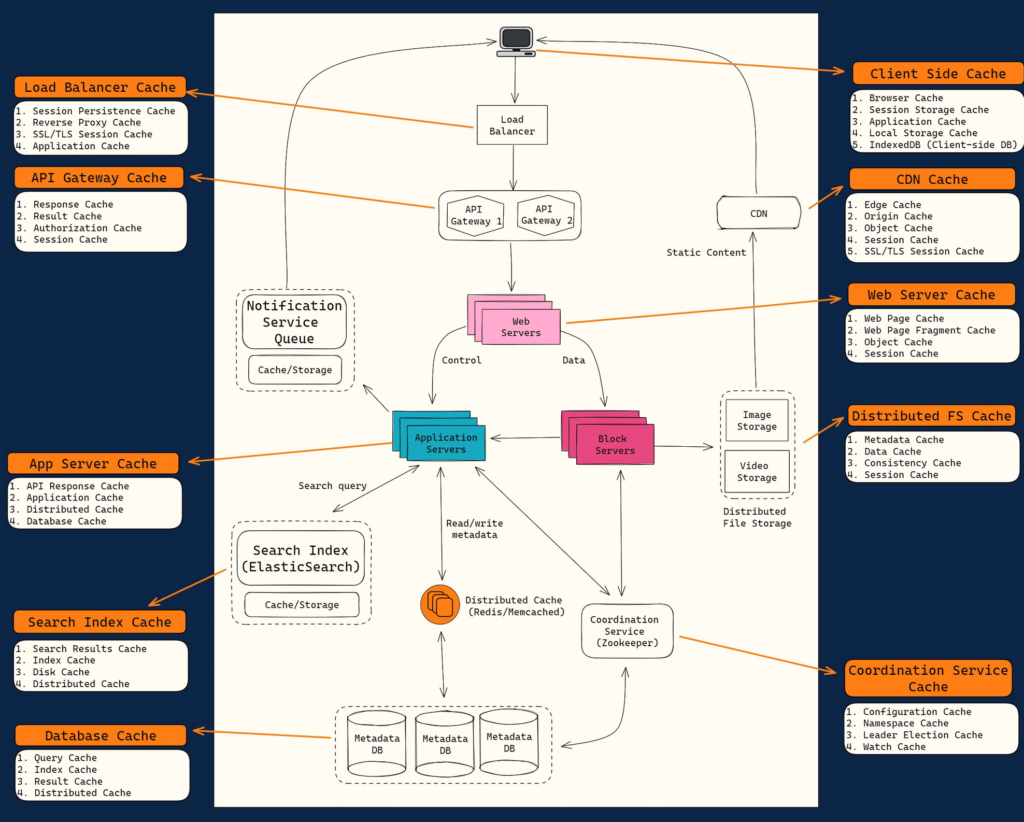Types of Caching
In this tutorial, we are going to discuss about types of caching. Caching can be implemented in various ways, depending on the specific use case and the type of data being cached.

Here are some of the most common types of caching.
1. Client-side caching
This type of caching occurs on the client device, such as a web browser or mobile app. Client-side caching stores frequently accessed data, such as images, CSS, or JavaScript files, to reduce the need for repeated requests to the server. Examples of client-side caching include browser caching and local storage.
- Web Browser Cache: Web browsers store resources such as HTML pages, CSS files, JavaScript files, images, and multimedia content locally on the user’s device. This allows the browser to serve cached content without re-downloading it from the server, speeding up page load times and reducing network bandwidth usage.
- Mobile App Cache: Mobile applications can cache data and resources locally on the user’s device to improve performance and reduce the need for frequent network requests. Cached data may include user preferences, app settings, frequently accessed content, and temporary data.
2. Server-side caching
This type of caching occurs on the server, typically in web applications or other backend systems. Server-side caching can be used to store frequently accessed data, precomputed results, or intermediate processing results to improve the performance of the server. Examples of server-side caching include full-page caching, fragment caching, and object caching.
- Application-Level Cache: Application servers can cache frequently accessed data or computation results in memory to improve response times and reduce database load. This can include caching database query results, API responses, rendered web pages, and other dynamic content.
- Database Query Cache: Some database management systems (DBMS) support query caching, where the results of frequently executed database queries are stored in memory. This reduces the need for redundant query processing and improves query response times.
- Object-Relational Mapping (ORM) Cache: ORM frameworks such as Hibernate in Java or Entity Framework in .NET provide caching mechanisms to store and retrieve objects from memory, reducing the need for repeated database queries and improving application performance.
3. In-memory caching
In-memory caching stores data in the main memory of the computer, which is faster to access than disk storage. In-memory caching is useful for frequently accessed data that can fit into the available memory. This type of caching is commonly used for caching API responses, session data, and web page fragments. To implement in-memory caching, software engineers can use various techniques, including using a cache library like Memcached or Redis, or implementing custom caching logic within the application code.
4. Disk caching
Disk caching stores data on the hard disk, which is slower than main memory but faster than retrieving data from a remote source. Disk caching is useful for data that is too large to fit in memory or for data that needs to persist between application restarts. This type of caching is commonly used for caching database queries and file system data.
5. Database caching
Database caching stores frequently accessed data in the database itself, reducing the need to access external storage. This type of caching is useful for data that is stored in a database and frequently accessed by multiple users. Database caching can be implemented using a variety of techniques, including database query caching and result set caching.
6. CDN caching
CDN caching stores data on a distributed network of servers, reducing the latency of accessing data from remote locations. This type of caching is useful for data that is accessed from multiple locations around the world, such as images, videos, and other static assets. CDN caching is commonly used for content delivery networks and large-scale web applications.
7. DNS caching
DNS cache is a type of cache used in the Domain Name System (DNS) to store the results of DNS queries for a period of time. When a user requests to access a website, their computer sends a DNS query to a DNS server to resolve the website’s domain name to an IP address. The DNS server responds with the IP address, and the user’s computer can then access the website using the IP address. DNS caching improves the performance of the DNS system by reducing the number of requests made to DNS servers.
When a DNS server receives a request for a domain name, it checks its local cache to see if it has the IP address for that domain name. If the IP address is in the cache, the DNS server can immediately respond with the IP address without having to query other servers. This can significantly reduce the response time for DNS queries and improve the overall performance of the system.
8. Full-Page Caching
Full-page caching stores entire web pages in memory or on disk to serve to users without re-rendering or regenerating the page content. This is commonly used in content management systems (CMS), e-commerce platforms, and dynamic web applications to improve page load times and reduce server load.
What and where to use caching?
Caching can be used in various parts of a system architecture to improve performance, scalability, and user experience. Here are some common scenarios and recommendations for where to use caching:

Each type of caching has its advantages and trade-offs, and the choice of caching strategy depends on factors such as application requirements, scalability needs, resource constraints, and performance goals. By strategically implementing caching at various levels of a system architecture, developers can optimize performance, improve scalability, and enhance the overall user experience.
That’s all about types of caching. If you have any queries or feedback, please write us email at contact@waytoeasylearn.com. Enjoy learning, Enjoy system design..!!